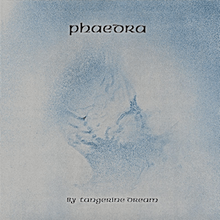Phaedra (album)
| Phaedra | ||||
|---|---|---|---|---|
 1974 LP album cover, by Edgar Froese | ||||
| Studio album by Tangerine Dream | ||||
| Released | 20 February 1974 | |||
| Recorded | December 1973, The Manor, Shipton-on-Cherwell | |||
| Genre | Electronic music, Ambient | |||
| Length | 37:33 | |||
| Label | Virgin | |||
| Producer | Edgar Froese | |||
| Tangerine Dream chronology | ||||
| ||||
| "Mysterious Semblance at the Strand of Nightmares" | |
|---|---|
| Single by Tangerine Dream | |
| A-side | "Mysterious Semblance at the Strand of Nightmares" (excerpt) – 4:30 |
| B-side | "Phaedra" (excerpt) – 2:02 |
| Released | 1974 |
| Format | 7" vinyl Promo |
| Label | Virgin/Atlantic |
| Professional ratings | |
|---|---|
| Review scores | |
| Source | Rating |
| Allmusic | |
| Piero Scaruffi | (7/10)[2] |
Phaedra (1974) is an album by the German electronic music group Tangerine Dream.
This is the first Tangerine Dream album to feature their now classic sequencer-driven sound, which launched the Berlin School genre. This album marked the beginning of the group's international success and was their first album released on the British Virgin records label. It achieved six-figure sales in the UK, reaching No 15 in the charts in a 15-week run,[3] with virtually no airplay, only by strong word of mouth. It also earned the group a gold disc in seven countries,[4] and yet in their native Germany it sold barely 6,000 units.[5]
The title track was originally based on an improvisation recorded in the studio, and unintentionally exhibits one of the limitations of the analog equipment used at the time. As the equipment warmed up, some of the oscillators began to detune (they were highly temperature-sensitive), which was responsible for some of the changes in the music towards the end of the piece.
The title track and "Movements of a Visionary" rely on Christopher Franke's use of the Moog analog sequencer as a substitute for bass guitar. "Mysterious Semblance at the Strand of Nightmares" features Edgar Froese soloing on a Mellotron which is treated to slowly sweeping filter effects. "Sequent C'" is a short but memorable piece by Peter Baumann on flute, with tape echo.
The All Music Guide to Electronica describes the album as a milestone for the band as "one of the most important, artistic, and exciting works in the history of electronic music".[6] Phaedra is commonly cited as one of Tangerine Dream's best albums[7][8] and is listed in 1001 Albums You Must Hear Before You Die.[9] In the Q and Mojo Classic Special Edition Pink Floyd & The Story of Prog Rock, the album also came #38 in its list of "40 Cosmic Rock Albums".
The sleeve design and cover painting are by Froese.[10]
Track listing
| No. | Title | Length | |
|---|---|---|---|
| 1. | "Phaedra" (Froese, Franke, Baumann) | 17:39 | |
| 2. | "Mysterious Semblance at the Strand of Nightmares" (Froese) | 9:55 | |
| 3. | "Movements of a Visionary" (Froese, Franke, Baumann) | 7:56 | |
| 4. | "Sequent C'" (Baumann) | 2:13 |
Note: Some CD releases from 1995 and 2005 have slightly different lengths
Personnel
- Edgar Froese – production, mellotron, guitar, bass, VCS 3 synthesizer, organ, cover painting
- Peter Baumann – organ, electric piano, VCS 3 synthesizer, flute
- Christopher Franke – moog synthesizer, VCS 3 synthesizer
Chart performance
| Chart (1974) | Peak position |
|---|---|
| UK Albums Chart[3] | 15 |
| US Billboard 200[11] | 196 |
References
- ↑ Bush, John. "Phaedra — Review". AllMusic.
- ↑ Scaruffi, Piero (1999). "Tangerine Dream". pieroscaruffi.com. Retrieved 16 August 2013.
- ↑ 3.0 3.1 "Chart Stats - Tangerine Dream - Phaedra". Archived from the original on 3 January 2013.
- ↑ Irvin, Jim (2007). The Mojo Collection: The Ultimate Music Companion (4th ed.). Edinburgh: Canongate. p. 326. ISBN 1841959731.
- ↑ Stump, Paul (1999). Digital Gothic: A Critical Discography of Tangerine Dream. Firefly Publishing. p. 52. ISBN 0-946719-18-7.
- ↑ Bogdanov, Vladimir (2001). All Music Guide to Electronica (2nd ed.). San Francisco: Backbeat Books. p. 505. ISBN 0879306289.
- ↑ Fitzpatrick, Rob; Roland, Mark (2006). Gods of Rock. New York: Main Street. p. 107. ISBN 1402736738.
- ↑ Abramowitz, Ari (2004). The Pockit Rockit Music Finder. New York: Music Guru. p. 44. ISBN 0975978705.
- ↑ Dimery, Robert (2006). 1001 Albums You Must Hear Before You Die. p. 323. ISBN 0-7893-1371-5.
- ↑ "Phaedra" at connollyco.com
- ↑ "Phaedra > Charts & Awards > Billboard Albums". Allmusic. Retrieved 12 October 2009.
External links
- Berling, Michael. "Phaedra". Voices in the Net. Retrieved 12 October 2009.
- Tangerine Dream - Phaedra (LP) at Discogs